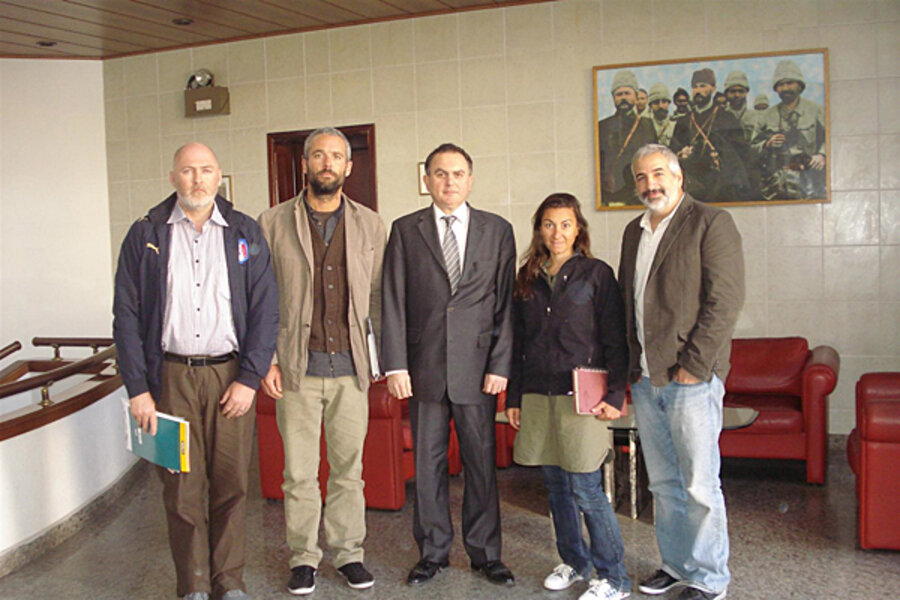In Libya’s war, journalists themselves become part of the story
Loading...
The publication Tuesday of four New York Times journalists’ account of their captivity by Qaddafi loyalists has put reporters working in Libya in the spotlight. The four were captured on March 15 by Qaddafi forces, later transferred to Libyan government authorities, and released on March 21.
From the beginning of their professional training, journalists are warned against doing anything that would make them, rather than the events they’re covering, the story. But in Libya, where according to the Committee to Protect Journalists (CPJ) there have been at least 36 detentions, two deaths, and various other attacks on journalists since protests began in mid-February, the danger posed to journalists is quickly becoming one of many narratives.
Qaddafi loyalists have repeatedly threatened to treat them like “terrorists” and the government said that any journalists caught in the country without visas – most of foreign press corps there, especially in the east – would be assumed to be Al Qaeda operatives and treated as such.
Monitor reporter Dan Murphy described the change in mood after the murder of Al Jazeera cameraman Ali Hassan al Jaber.
Many foreign reporters in Benghazi are now preparing to move out of the city, frightened by Mr. Qaddafi’s advance, his repeated threats to treat journalists like “terrorists,” and the murder of Mr. Jaber.
... Foreign reporters at some of the city’s hotels have had their rooms searched and there’s a firm belief among Libyans here that the massive explosion at the city’s largest munitions dump last week was an act of sabotage.
Last night, even as thousands of citizens gathered outside the Benghazi courthouse to mourn and hail the murdered Jaber, waving both Qatari and "Free Libya" flags, one foreign reporter returning to his hotel was approached by two men riding on a motorbike. “Go home, go home,” they shouted at him.
It was a small incident, but something that would have been unthinkable even a week ago, when foreign reporters couldn’t even pay for their own cups of coffee or cellphone cards as Libyans here insisted foreign coverage of the uprising was crucial to their success.
Meanwhile, the Libyan government has allowed some journalists, including Monitor reporter Scott Peterson, into Tripoli under close surveillance. Those journalists are receiving tours of the destruction and fighting and attending press conferences under the heavy hand of government officials and loyalists.
After several attempts to enter Libya by way of the Tunisian border, Mr. Peterson finally received a government escort into Tripoli this week. His journey revealed tight government and military control over the towns along the road, including those that security forces were supposed to leave, per UN Resolution 1973, which authorized the foreign air strikes on Libya.
Other reporters were taken by government officials to the site of Western air strikes and told by Qaddafi loyalists that the strikes were an assassination attempt on Qaddafi.
CPJ reported on March 13 that “foreign journalists have been hampered by pro-Qaddafi forces since fighting began in February…. Libyan authorities had invited international journalists to report from the capital, but pro-Qaddafi forces have constantly hampered their work.”
In western Libya, journalists have often had few options other than to go along with government officials. But some media outlets have been criticized for doing so. On March 22, Fox News correspondent Jennifer Griffin reported that Qaddafi’s forces had averted air strikes by using CNN and Reuters journalists as human shields, perhaps implying that CNN and Reuters had some hand in influencing events.
The CNN and Reuters journalists were accompanied by Libyan officials to a military compound, where they were shown damage from Western air strikes, Ms. Griffin reported. While CNN didn't deny that visit, they fiercely denied the possibility that their 20-minute tour could have been enough time to use them as human shields. Correspondent Nic Robertson in Libya:
"To say it was a human shield is nuts," Robertson said, later adding: "I expect lies from the government here. I don't expect it from other journalists. It's frankly incredibly disappointing."
CNN also responded that a representative of Fox News – although a security guard, not a news crew member – had been on the tour, with a camera. Fox News later appended a correction to its initial report.
The US State Department has repeatedly urged journalists operating in the country to be cautious, and the Associated Press reported this weekend that State recommended that news organizations stop sending journalists into the country.





